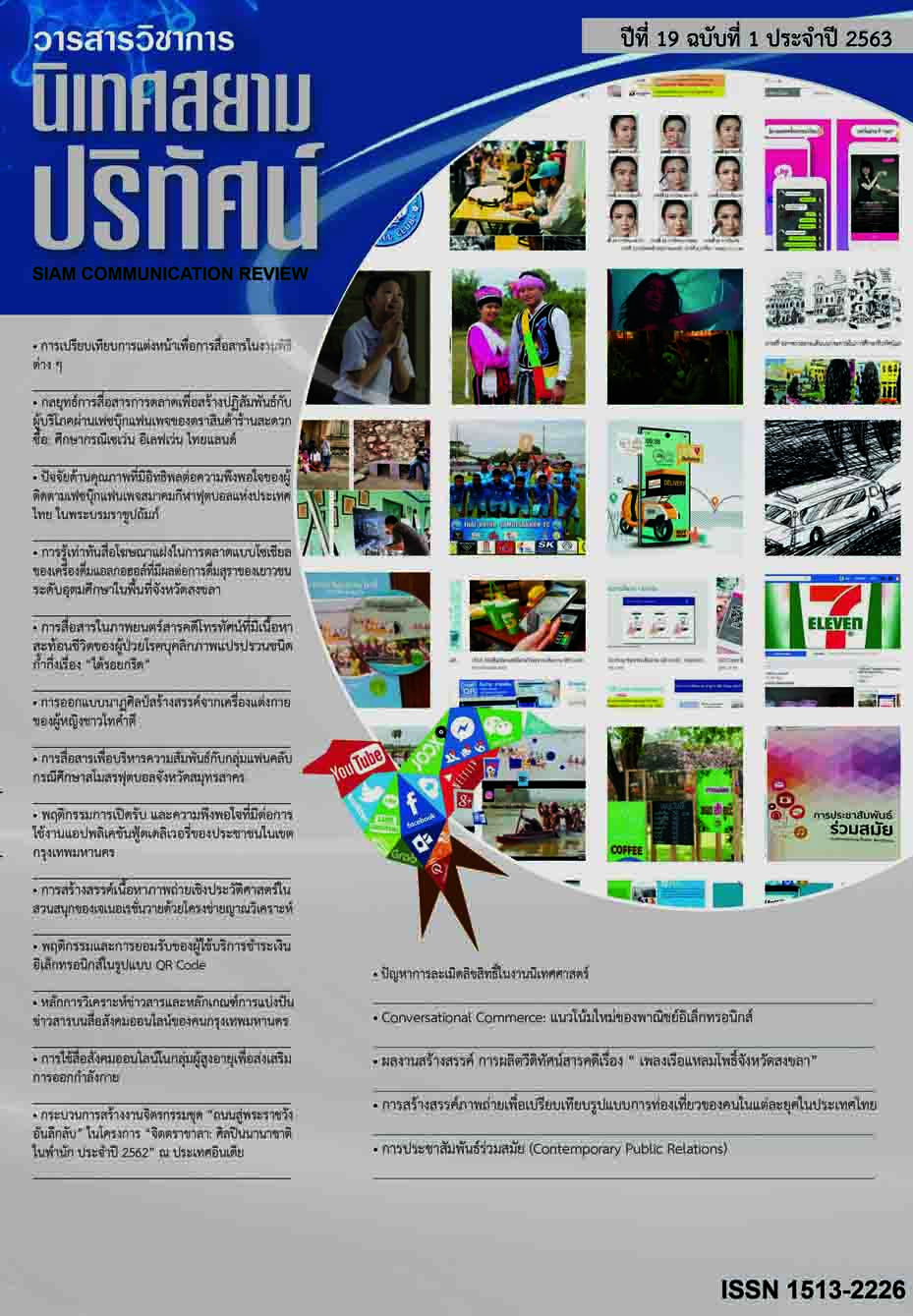The Indirect Advertising on Social Media Marketing of Alcohol Beverages Affected to Youth Drinking and Media Literacy of University Student in the Area of Songkhla Province
Main Article Content
Abstract
This research article was based on a mix-method research design in order to accomplish the purpose were 1) to study indirect advertising on social media of alcoholic advertising in Thailand 2) to study the influence of indirect advertising on social media of alcohol advertising that affect alcohol drinking behavior of youth in undergraduate in Songkhla province and 3) to examine media literacy of indirect advertising on social media of alcoholic advertising of youth in undergraduate in Songkhla province . The research methods are collecting qualitative and quantitative data from three types of social media such as youtube, facebook and twitter. A sample was selected by 400 students in five universities at Songkhla that were Prince of Songkla University on Hat Yai Campus, Songkhla Rajabhat University, Rajamangala University of Technology Srivijaya, Thaksin Songkhla University and Hat Yai University with a focus group discussion of 30 key informants.
The research finding could be summarized into 3 points. The classical placement was the most of indirect advertising form which had been found. The evocative placement, the corporative placement and the stealthy placement were following. The process of indirect advertising via the alcoholic advertisement was started by the senders. They would judge by the popularity of products. The entertainment and the interesting lifestyle would be shown in their advertising contents. On the other hand, if it wasn’t a famous product, the product’s quality would be considered by the expert. The audiences’ recommendation which shown as “like and share” could estimate how popular the advertising is. The finding was found that the influences of indirect advertising on social media were related to the alcohol drinking behavior of undergraduate youths in Songkhla province. The high correlation coefficient (r = 0.688), it was predicted that 68.9%. The alcohol drinking video clip was the highest influence response (β = .291). The atmosphere of the restaurant (β = .265) and the image of favorite singer in target group (β = .234). The media literacy of indirect advertising on social media of alcoholic advertising , most of youths groups are knowledgeable and could inform the hidden advertisements by analyzing and evaluating the suitable content through online media. Attraction or things that are induced to settle the market for food and beverage manufacturers. It shouldn’t need to resist or press the button. Sometimes it may be necessary to produce the awareness media and to keep up these alcoholic advertising online media for reducing the effects among adolescents. The educational institutions might be the other ways to help the youths having more media literacy, more confidently and safely.
Article Details
References
กัณต์กนิษฐ์ ผลแจ้ง. (2555). ปัจจัยที่มีอิทธิพลต่อการดื่มแอลกอฮอล์ของนักศึกษาระดับปริญญาตรีในเขตกรุงเทพมหานคร. วิทยานิพนธ์นิเทศศาสตรมหาบัณฑิต, มหาวิทยาลัยศรีปทุม.
ณัฐชนันท์ กิ่งมณี. (2554). การศึกษาการรับรู้โฆษณาตรงและโฆษณาแฝงสินค้าเครื่องดื่มแอลกอฮอล์ทางโทรทัศน์ในกลุ่มนักศึกษาระดับอุดมศึกษา. วิทยานิพนธ์นิเทศศาสตรมหาบัณฑิต, มหาวิทยาลัยรังสิต.
ณัฐวิภา สินสุวรรณ (2553). การวิเคราะห์ตัวบทและการถอดรหัสความหมายเชิงสัญญะของโฆษณาเครื่องดื่มแอลกอฮอล์ในสังคมไทย. วิทยานิพนธ์นิเทศศาสตรมหาบัณฑิต, จุฬาลงกรณ์ มหาวิทยาลัย.
เทอดศักดิ์ ไม้เท้าทอง. (2557). การรู้เท่าทันสื่อ: ทักษะสำหรับการเรียนรู้ในศตวรรษที่ 21. วารสารสารสนเทศศาสตร์ กลุ่มวิชาการจัดการสารสนเทศและการสื่อสาร, 32(3), 74-91.
บรรจง พลไชย. (2555). พฤติกรรมการดื่มเครื่องดื่มแอลกอฮอล์ของนักเรียนชั้นมัธยมศึกษาปีที่ 4– 6 ในโรงเรียนมัธยมศึกษาในเขตเทศบาลเมืองนครพนม. นครพพนม: วิทยาลัยพยาบาลบรมราชนนี มหาวิทยาลัยนครพนม.
มธุรดา สุวรรณโพธิ์. (2557). นักดื่มหน้าใหม่. เพื่อนรักษ์สุขภาพจิต, 14(57), 4.
รดี ธนารักษ์. (2558). การรู้เท่าทันสื่อ : ประโยชน์และการนำไปใช้กรณีศึกษามหาวิทยาลัยราชภัฏอุตรดิตถ์. กรุงเทพฯ : สำนักงานคณะกรรมการกิจการกระจายเสียง กิจการโทรทัศน์และกิจการโทรคมนาคมแห่งชาติ.
ศรีรัช ลาภใหญ่. (2550). การศึกษางานโฆษณาเครื่องดื่มแอลกอฮอล์ที่มีผลต่อความรู้สึกอยากทดลองดื่มและการจดจำตราสินค้าในกลุ่มเยาวชนและวัยรุ่น. กรุงเทพฯ: ศูนย์วิจัยปัญหาสุรา (ศวส.) และสำนักงานกองทุนสนับสนุน การสร้างเสริมสุขภาพ (สสส.).
ศุภกิตติ์ ใจแข็ง. (2560). การเปิดรับสื่อ พฤติกรรมการดื่ม และความคิดเห็นต่อกิจกรรมการสื่อสารการตลาดของผู้ดื่มที่มีต่อธุรกิจเครื่องดื่มแอลกอฮอล์. สารนิพนธ์วารสารศาสตรมหาบัณฑิต, มหาวิทยาลัยธรรมศาสตร์.
สำนักงานสถิติแห่งชาติ. (2557). การสำรวจพฤติกรรมการสูบบุหรี่และการดื่มสุราของประชากร พ.ศ. 2557. กรุงเทพฯ: เท็กซ์ แอนด์เจอร์นัล พับลิเคชั่น.
อิทธิเทพ หลีนวรัตน์. (2560). การรับรู้ของเยาวชนที่มีต่อโฆษณาเครื่องดื่มแอลกอฮอล์กรณีศึกษาอำเภอพระนครศรีอยุธยา จังหวัดพระนครศรีอยุธยา.วารสารวิทยาลัยสงฆ์นครลำปาง, 6(1), 19-33.
ภาษาอังกฤษ
Lasswell, H. (1948). The structure and function of communication in society. The communication of idea. New York: Institute for Religious and Social Studies.
Sharpe, R. & Beetham, H. (2010). Rethinking learning for a digital age: How learners are shaping their own experiences. New York: Routledge.


